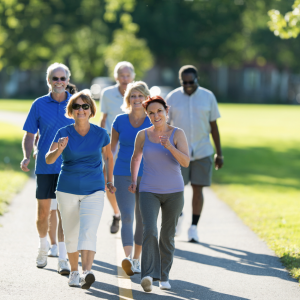Walking is something we do daily, whether it is a purposeful walk or run outdoors, or incidental walking from the car to the grocery store! Our gait can always be improved – and it is very doable even if you don’t have prior exercise experience. It is actually quite easy to work on and improve your gait.
Good strength and endurance in various leg muscles are important to ensure your gait is strong and healthy, making your walk more efficient. However, not only is strength important, but mobility is too! More often than not, when there is stiffness at a joint or in a muscle, gait is affected.
Strength
Walking involves all of the major muscle groups in your lower limb – calves, hamstrings, quadriceps, hip flexors, and glutes. Good strength in these muscles is important for efficient gait. These muscles all work together – during some phases of gait, some groups of muscles will be helping to propel you forward, and at the same time others will be working to keep you supported! Some strength exercises for the major muscle groups of the leg for gait include:
- Calves: calf raises, toe raises
- Hamstrings: heel to butt kicks (weighted or unweighted), hip hinges
- Quadriceps: knee extensions, foot rainbows, step ups (very functional!)
- Hip flexors: high knee marching, weighted leg lifts
- Glutes: glute bridges, standing hip extensions
All of these exercises are universally known and can be done at home with little to no equipment. If you are wanting more information, contact your trusted Accredited Exercise Physiologist for some technique guidance!
Mobility
Strength is important, but – as mentioned above – if there is stiffness in a joint or a muscle, gait will often be altered and this can result in compromised function elsewhere in the body! Therefore, we need to make sure we address both strength and mobility equally in a walking program. Some mobility exercises include:
- Calf stretches, toe points and forward/backward weight shifting
- Hamstring stretch – either lying down or sitting and reaching for the toes
- Quadriceps stretch
- Knee to chest stretches, glute stretch
As with all mobility, ease into these movements and make sure to breathe through them. If you feel uncomfortable with a stretch, it will not benefit you. It is always more advisable to start gently and progress as you get more comfortable.
Balance
Balance goes hand in hand with strength and mobility when it comes to gait! In the swing phase of gait, one of your feet will come off the ground – effectively putting you in a single leg balance! Strength exercises will help with this, but practicing some balance is beneficial too.
- Single leg balance in a safe space – aim for 20-30 seconds on each foot
- ‘Rocker’ (forward/backward weight shift) – imagine you are a rocking chair, shifting your weight forward and back! The challenge is that once you feel overbalanced, you need to catch and right yourself! This is a very functional gait/balance exercise and really mimics walking.
Practice
Absolutely nothing beats walking practice to improve your walking! Some tips include:
- Good footwear with the appropriate support you may need for your foot health
- If you are walking laps around an oval, be sure to do half going in one direction then half going in the other direction – this way if there are any imbalances with the surface such as a slight incline, it will not be biased on one side of your body
- Include a variety of surfaces – depending on your body tolerance, you may like to try (if available) sand, grass, asphalt and/or gravel! You can also try adding in some steps – both up and down – and a hill climb or two for some variety.
- Posture: Be sure to stand tall and look ahead whilst walking. A lot of people, particularly seniors, tend to look down at the ground to avoid trip hazards. This is completely understandable! Unfortunately, if you are walking while looking down at your feet, your balance and posture are impacted and your body weight is shifted forward. Try standing with your chest proud and shoulders back. If you are nervous about falling, you can look down at a 45o angle so you can see in front of you on the ground but not down at your feet

